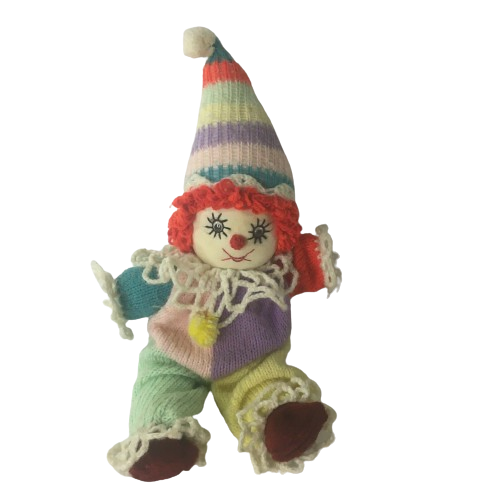.gif) the history of clowning
the history of clowning 
clowns have been around and making people smile and laugh since the beginning of civilization. sadly, the profession seems to be in decline for several reasons. a lot of bigger traveling circuses are shutting down due to issues of animal abuse; it's definitely good that the animals are no longer being forced to perform, but although most performers were not to blame for the abuse taking place, it put many out of a job. to make matters worse, with the growing popularity of 'killer clowns' in horror media, around 2016 many people across the U.S. decided to buy scary clown masks and terrorize strangers at night. all of this has led to a lot of misconceptions about clowns, which is why i want to share the history of the profession and give a different perspective!

before going into the history of clowning, it's important to point out that although they were originally 'kept' by rulers/kings (sometimes due to physical deformities or intellectual disabilities), they were usually treated better than most slaves. court jesters were given a great deal of respect and sometimes even influenced these rulers' decisions. in some cultures, including native tribes, clowns took on a somewhat spiritual role as well.
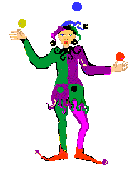
- one of the earliest recorded performances were that of the imperial court jesters in China. emporer Shih Huang-Ti (around 300 B.C.), who oversaw the building of the Great Wall of China, had a jester named Yu Sze. despite many people dying during the construction of the wall, the emporer was considering having the wall painted as well. realizing how detrimental this decision would be to his people, Yu Sze was the only person brave enough to criticize it (through jest); the emporer promptly decided to abandon this plan.
- Egyptian pharaohs also had jesters: a pygmy clown performed in leopard skins for the court of Pharaoh Dadkeri-Assi during the 5th dynasty. one young pharaoh descriped them as 'a divine spirit -- to rejoice and delight the heart'.
- Ancient Greece had clowns; they often sported some type of mask and an exaggerated phallus strapped to their waist (apparently dick jokes are nothing new). Sparta had clowns called 'Deikeliktas', meaning 'those who put on plays'.
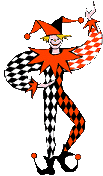
- of course, Ancient Rome had clowns as well, which is where there became several deviations from the traditional court jester. some of the types of clowns that existed were 'Sannio', 'Stupidus', 'Scurra', and 'Moriones'. some of the things most people associate with clowns, such as colorful clothing, exaggerated facial expressions, and physical humor, gained western popularity in ancient Greece and Rome.
- in 8th century East Asia, Harun al-Rashid, 5th caliph (Islamic leader) of the Abbasid dynasty and one of the builders of the Taj Mahal, had a court jester named Bahalul. when al-Rashid asked his jester to compile a list of all the fools in Baghdad, Bahalul replied, 'That would be difficult, oh Commander of the Faithful, but if you desire to know the wise men, the catalogue may soon be completed!'
.gif)
- Aztec king Montezuma also had jesters for his court; when Cortez conquered the Aztec nation in 1520 A.D. he brought many of these jesters back to Pope Clement VII, noticing that they had many similarities to the ones in Europe.
- the Harlequin character originated in 16th century Italy with the 'Commedia del Arte', a form of (mostly) improv street theatre based on a set list of comedic scenarios. characters were either masters or servants, with clowns depicting the latter. there were usually 3 servants: first zany (the smart, scheming one), second zany (the fool and follower), and fantesca (their female counterpart and potential love interest).
.png)
in these theatrical shows, Harlequin was originally second zany, whose ignorance caused him to be perpetually victimized by the clever first zany. as these performances heavily relied on improvisation, performers started to play Harlequin as a smarter character until eventually he was characterized as first zany.
- Harlequin became so popular that the character was

brought to English performances and made the star of the show. he would be put into crazy situations such as being chased by police, and was given a stick that he could hit to magically change the scene. if you hadn't guessed, this is where the comedic term 'slapstick' came from. these performances are also where the first whiteface clown, the Pierrot, made an appearance.
- although i have been referring to these goofy characters as 'clowns', this term was actually first coined in 17th century England by William Shakespeare;

it is believed that he derived it from the Danish word 'klunni', meaning clumsy or cloddish. Yorick, a court jester mourned by Hamlet in the
famously tragic play, was one character that Shakespeare dubbed a clown:
'Alas, poor Yorick! I knew him, Horatio: a fellow
of infinite jest, of most excellent fancy: he hath
borne me on his back a thousand times; and now, how
abhorred in my imagination it is! my gorge rims at
it. Here hung those lips that I have kissed I know
not how oft. Where be your gibes now? your
gambols? your songs? your flashes of merriment,
that were wont to set the table on a roar? Not one
now, to mock your own grinning? quite chap-fallen?
Now get you to my lady's chamber, and tell her, let
her paint an inch thick, to this favour she must
come; make her laugh at that.'
- two major innovators (although at different times) were in Lord Chandler's Men, an acting troupe that Shakepeare wrote plays for. these two men where named William Kemp and Robert Armin. Kemp typically played stupid 'country bumpkin' characters (which would later be known as Auguste), while Armin specialized in the depiction of fools and court jesters. Armin wrote one of the first books on the history of the profession, which can be read for free here:

- in 1768, Phillip Astley opened what is considered to be the first circus in london. it mainly began as a show of horseback stunts, as Astley was a former member of the British cavalry. in order to add variety to the show, he created an act that he called 'Billy Buttons', also known as 'The Tailor's Ride To Brentford' that would be performed by some of the very first circus clowns. the act was based on a popular comedic tale about a tailor who is terrifically
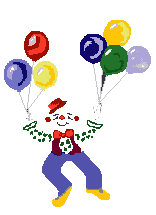
bad at riding horses, but attempts to do so anyway because he wants to go vote in the election. it involved the clowns riding, and falling off of, a trained horse during these performances and can still be seen in some circuses today.
- although Astley is credited as opening the first circus, he never actually called his performances that. the word
circus originally came from latin, meaning 'circle', or 'ring'. its earliest usage was in Rome, where shows for large crowds took place such as chariot races and wild animals and slaves being used in garish exhibitions of gladitorial strength in the giant colosseum. aside from the shape of the entertainment venue and the use of animals, astley's circus did not resemble the Roman circus and was considerably more humane.
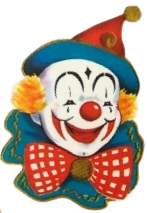
- one of the biggest names in clowning history is Joseph Grimaldi (1778-1837), as all clowns are nicknamed 'Joey' in honor of him. he is considered to be the first whiteface clown because he popularized the look that most clowns base their makeup on to this very day. he was strictly a theatrical clown and gained wide fame in london for his ability to contort his face in a comedically exaggerated fashion, paired with his fittingly striking and melodromatic face paint and elevation of slapstick humor. his son, also named Joey, followed in his footsteps on theatrical clowning and sometimes performed with his father. both father and son also performed in blackface, which was common at the time, several times to depict the character 'Friday' from
Robinson Crusoe.
- unfortunately, like most forms of entertainment, modern clowning has a problematic history steeped in racism.
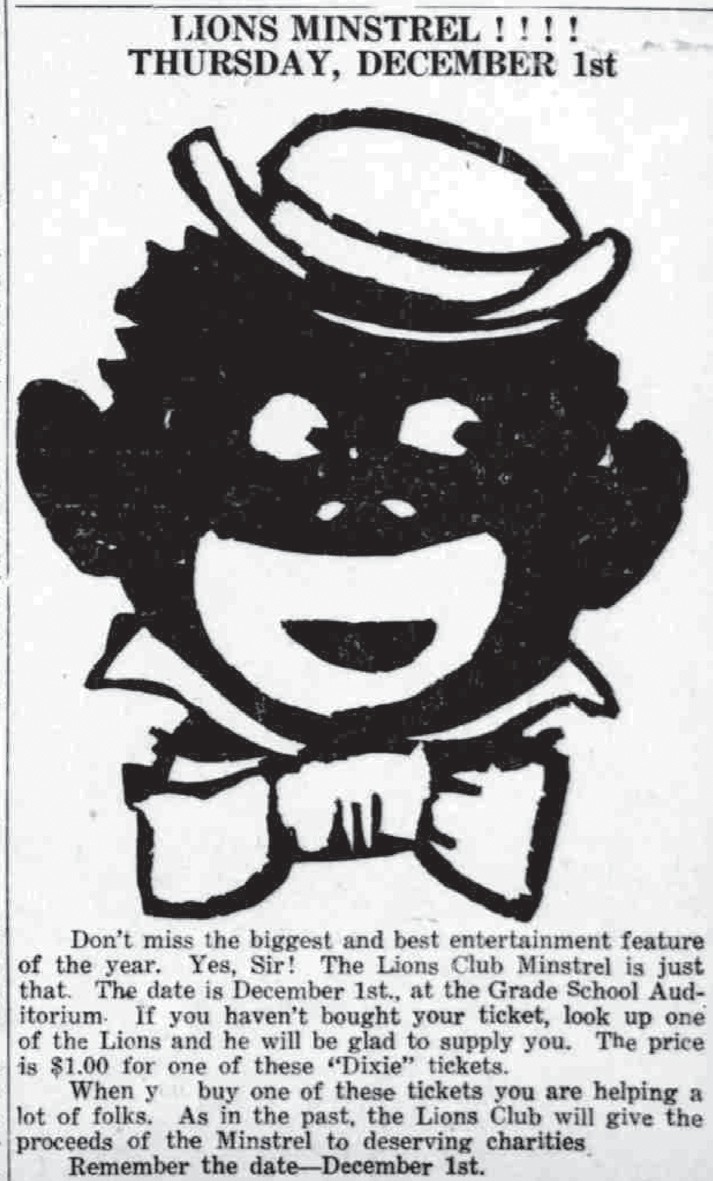
a lot of sites detailing clown history tend to shy away from this topic, but i personally think it's important to be informed about rather than sweeping it under the rug. clowns performing in blackface can be dated back to at least 1769, with 'Minstrel shows' gaining popularity around 1830 in both England and America. these performers claimed that they were simply acting out what they had observed from black slaves, but it was clear that their acts and makeup were heavily exaggerated to play into current stereotypes. for example, minstrel clowns wore oversized shoes because of the stereotype that black people have big feet. if you would like to read and learn more about this, you should absolutely check out
this article by Bruce Johnson, a.k.a. Charlie the Juggling Clown.
- shortly before the American civil war, a clown named 'Yankee' Dan Rice started to gain a name for himself by popularizing the 'Uncle Sam' character in multiple one-ring circuses.

he was known for wearing very patriotic red, white, and blue costumes covered in stars and stripes. he wrote many songs and campaigned for Zachary Taylor's presidency, even inviting him to ride on the circus bandwagon. this is supposedly where the phrase "jumping on the bandwagon" came from, as other politicians would also try to hop on in hopes that it would boost their votes. some more interesting things about Rice are that he claimed to be close friends with Abraham Lincoln, he was an active philanthropist, and it is said that he is the only person in history to present a tightrope-walking elephant in a circus act.
this compilation of clown history is still a work in progress!! please make sure to check back for updates, there is plenty more to come :o)








 home page
home page
 about the webmaster
about the webmaster
 my favorite clowns
my favorite clowns 
 killer clowns
killer clowns
 silly little links
silly little links
 clowncore moodboard
clowncore moodboard
.gif)
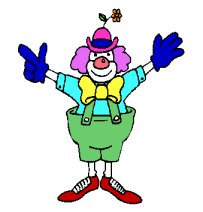

 Clowns Without Borders: Top Clown Schools in the U.S.
Clowns Without Borders: Top Clown Schools in the U.S.
 Clowns: A Misunderstood and Declining Profession
Clowns: A Misunderstood and Declining Profession
 Clownopedia (The Clown Wiki)
Clownopedia (The Clown Wiki)
.gif) the history of clowning
the history of clowning 

 - one of the earliest recorded performances were that of the imperial court jesters in China. emporer Shih Huang-Ti (around 300 B.C.), who oversaw the building of the Great Wall of China, had a jester named Yu Sze. despite many people dying during the construction of the wall, the emporer was considering having the wall painted as well. realizing how detrimental this decision would be to his people, Yu Sze was the only person brave enough to criticize it (through jest); the emporer promptly decided to abandon this plan.
- one of the earliest recorded performances were that of the imperial court jesters in China. emporer Shih Huang-Ti (around 300 B.C.), who oversaw the building of the Great Wall of China, had a jester named Yu Sze. despite many people dying during the construction of the wall, the emporer was considering having the wall painted as well. realizing how detrimental this decision would be to his people, Yu Sze was the only person brave enough to criticize it (through jest); the emporer promptly decided to abandon this plan.

.gif) - Aztec king Montezuma also had jesters for his court; when Cortez conquered the Aztec nation in 1520 A.D. he brought many of these jesters back to Pope Clement VII, noticing that they had many similarities to the ones in Europe.
- Aztec king Montezuma also had jesters for his court; when Cortez conquered the Aztec nation in 1520 A.D. he brought many of these jesters back to Pope Clement VII, noticing that they had many similarities to the ones in Europe.
.png)
 brought to English performances and made the star of the show. he would be put into crazy situations such as being chased by police, and was given a stick that he could hit to magically change the scene. if you hadn't guessed, this is where the comedic term 'slapstick' came from. these performances are also where the first whiteface clown, the Pierrot, made an appearance.
brought to English performances and made the star of the show. he would be put into crazy situations such as being chased by police, and was given a stick that he could hit to magically change the scene. if you hadn't guessed, this is where the comedic term 'slapstick' came from. these performances are also where the first whiteface clown, the Pierrot, made an appearance.
 it is believed that he derived it from the Danish word 'klunni', meaning clumsy or cloddish. Yorick, a court jester mourned by Hamlet in the famously tragic play, was one character that Shakespeare dubbed a clown:
it is believed that he derived it from the Danish word 'klunni', meaning clumsy or cloddish. Yorick, a court jester mourned by Hamlet in the famously tragic play, was one character that Shakespeare dubbed a clown:

 bad at riding horses, but attempts to do so anyway because he wants to go vote in the election. it involved the clowns riding, and falling off of, a trained horse during these performances and can still be seen in some circuses today.
bad at riding horses, but attempts to do so anyway because he wants to go vote in the election. it involved the clowns riding, and falling off of, a trained horse during these performances and can still be seen in some circuses today.
 - one of the biggest names in clowning history is Joseph Grimaldi (1778-1837), as all clowns are nicknamed 'Joey' in honor of him. he is considered to be the first whiteface clown because he popularized the look that most clowns base their makeup on to this very day. he was strictly a theatrical clown and gained wide fame in london for his ability to contort his face in a comedically exaggerated fashion, paired with his fittingly striking and melodromatic face paint and elevation of slapstick humor. his son, also named Joey, followed in his footsteps on theatrical clowning and sometimes performed with his father. both father and son also performed in blackface, which was common at the time, several times to depict the character 'Friday' from Robinson Crusoe.
- one of the biggest names in clowning history is Joseph Grimaldi (1778-1837), as all clowns are nicknamed 'Joey' in honor of him. he is considered to be the first whiteface clown because he popularized the look that most clowns base their makeup on to this very day. he was strictly a theatrical clown and gained wide fame in london for his ability to contort his face in a comedically exaggerated fashion, paired with his fittingly striking and melodromatic face paint and elevation of slapstick humor. his son, also named Joey, followed in his footsteps on theatrical clowning and sometimes performed with his father. both father and son also performed in blackface, which was common at the time, several times to depict the character 'Friday' from Robinson Crusoe.
 a lot of sites detailing clown history tend to shy away from this topic, but i personally think it's important to be informed about rather than sweeping it under the rug. clowns performing in blackface can be dated back to at least 1769, with 'Minstrel shows' gaining popularity around 1830 in both England and America. these performers claimed that they were simply acting out what they had observed from black slaves, but it was clear that their acts and makeup were heavily exaggerated to play into current stereotypes. for example, minstrel clowns wore oversized shoes because of the stereotype that black people have big feet. if you would like to read and learn more about this, you should absolutely check out this article by Bruce Johnson, a.k.a. Charlie the Juggling Clown.
a lot of sites detailing clown history tend to shy away from this topic, but i personally think it's important to be informed about rather than sweeping it under the rug. clowns performing in blackface can be dated back to at least 1769, with 'Minstrel shows' gaining popularity around 1830 in both England and America. these performers claimed that they were simply acting out what they had observed from black slaves, but it was clear that their acts and makeup were heavily exaggerated to play into current stereotypes. for example, minstrel clowns wore oversized shoes because of the stereotype that black people have big feet. if you would like to read and learn more about this, you should absolutely check out this article by Bruce Johnson, a.k.a. Charlie the Juggling Clown.
 he was known for wearing very patriotic red, white, and blue costumes covered in stars and stripes. he wrote many songs and campaigned for Zachary Taylor's presidency, even inviting him to ride on the circus bandwagon. this is supposedly where the phrase "jumping on the bandwagon" came from, as other politicians would also try to hop on in hopes that it would boost their votes. some more interesting things about Rice are that he claimed to be close friends with Abraham Lincoln, he was an active philanthropist, and it is said that he is the only person in history to present a tightrope-walking elephant in a circus act.
he was known for wearing very patriotic red, white, and blue costumes covered in stars and stripes. he wrote many songs and campaigned for Zachary Taylor's presidency, even inviting him to ride on the circus bandwagon. this is supposedly where the phrase "jumping on the bandwagon" came from, as other politicians would also try to hop on in hopes that it would boost their votes. some more interesting things about Rice are that he claimed to be close friends with Abraham Lincoln, he was an active philanthropist, and it is said that he is the only person in history to present a tightrope-walking elephant in a circus act.





























































